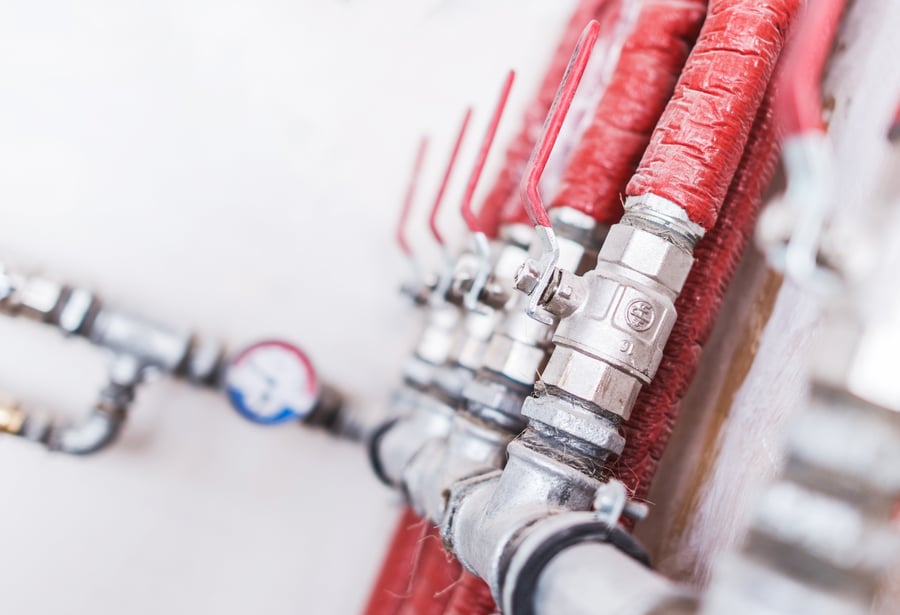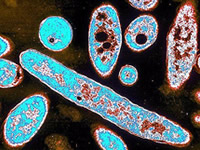
A number of waterborne bacteria view closed water systems as something of a des res, providing the conditions are favourable and everything they need to feel at home is on tap, so to speak. A compendium of features which would make us shudder, yet represent a rich stream of sustenance for potentially dangerous bacterial forms which are attracted by the presence of the three equally uninvited house guests which lure them in from the outset. They are of course, biofouling, scale deposits and corrosion. Leave these mod cons to their own devices and it won’t be long before the likes of Legionella makes itself comfortable in places you REALLY don’t want it to be. Both closed heating and cooling systems are particularly vulnerable to bacteria-based squatters, the physical existence of which could lead to illness and worse, if not discovered and subsequently evicted as quickly as possible.
So, tell me more about these three primary threats which could be lurking in my closed water system?
The three biggest culprits are the aforementioned biofouling, scale and corrosion, all of which can wreak havoc in the confines of either a hot or cold water system if undetected/left to their own devices. But just what form do these noxious entities take and how do they manifest in the first place? Well, with regards to biofouling (which is another term used colloquially to describe the accumulation of bacterial properties within the constructs of a conventional closed water system), we’re referring to the trace elements of the bacteria itself with dangerously high levels and concentrates of Legionella (et al) adding to scale and corrosion. Yet in a cruel twist, both of these are what Legionella can and does feed off, so it’s tantamount to a vicious circle which can self-perpetuate quickly if and when unobserved.
Corrosion is pretty much as it says on the tin. In as much as we’re talking about the build-up of rust and other particles which present when an infrastructure is physically decaying and not being closely or routinely monitored by those responsible. Moreover, once corrosion takes hold, it can lead to leaks and the often inevitable shortening of lifespans for the system’s plant and component features.
Additionally, scale can infiltrate a closed water system as a whole, and can invariably result in clogged up pumps, while severely compromising the essential functionality of associated equipment in situ; and which is crucial to the smooth running of an internal water storage/distribution system. This will significantly impact on the efficiency and expected lifecycle of said system, with heat transfer being a moot point in this eventuality. Generally-speaking, the upshot of scale leaving its mark on a closed water system can have a damaging medium and long-term effect on a number of scores, not least public health as we’ve already insinuated. However in terms of assemblage, the ramifications which are by-products of the damaging presence of scale are energy waste, the replacement of key system components and depleted performance.
What solutions are available to insure against unwanted penetration of a closed water system by damaging ingredients?
As always, being proactive is always a better idea than simply reacting to a problem, a mantra which is never better illustrated than when it comes to addressing the question of closed water system treatments; and specifically, the different types available to the consumer. Understandably, the actual best line of defence for you to take will largely depend on the type of closed system you’re looking to either protect, or in the worst case scenario, rectify, in the immediate aftermath of noting potentially damaging elements already in situ and at work. And it’s not only system types, but materials and conditions at the time which have to be taken into account too, before deciding on the best course of action.
By identifying the type of closed water system and determining which treatment would therefore benefit it most, optimum levels of both performance and efficiency can be targeted going forward; and in the direct aftermath of a dedicated treatment being implemented. Water pressures are pivotal deciding factors – especially when running the rule over hot water systems – with low, medium and high being key to approach from the outset. Meanwhile paying particular attention to the raw materials from which the closed water system has been manufactured from also has to be high up the agenda. Brass, copper and aluminium will necessitate their own, individual treatments when it comes to protective issues. So already we’re building a more detailed picture of how systems and ergo, treatments may differ from application to application.
Describe the core treatments for hot and cold water closed water systems
The most pressing concern – and which an appropriate and all-consuming treatment will tackle head on – regards dealing with the three core issues discussed earlier (corrosion, scaling, biofouling), along with freezing and foaming. All of which need eradicating in order to safeguard the efficiency of a system and, ultimately, any public health fears with direct reference to Legionella bacteria and its proliferation under the right conditions. Naturally any treatments performed on closed water systems wherever they are found, need to strictly adhere to existing industry legislation and follow current compliance. Which is another reason why you should always recruit water treatment specialists to carry out system treatments, as and when required.
What are scale and corrosion inhibitors?
Fundamentally, nitrate and molybdate are the two predominant variations on a scale and corrosion inhibitor theme; and the most prolifically frequented means to this end employed in the water treatment sector here in the UK. They can be used individually or in some instances in unison; as a double-pronged defence mechanism. Together both properties fuse to cover all bases and are seen by many as a futureproof way of controlling scale and corrosion. Ostensibly, nitrate works immediately, striking fear into the heart of the corrosion, while the molybdate creates a protective film over troublesome surface areas so as to prevent any further intrusion.
As individual combatants against the twin threat of scale and corrosion, nitrate is more normally used in older water systems; those typically forged from steel and iron parts. What it can’t be used in is heated or chilled water systems which comprise of aluminium or zinc however, as it has a tendency to literally eat through softer metals such as these, which will eventually produce holes and subsequent leaks. Molydbate on the other hand is an altogether different beast, and creates a hardened film which covers internal surfaces of pipework and associated assemblage, thus forming a barricade to any noxious elements waiting in the wings to establish itself. Basically, molybdate works wonders on the type of closed water system surfaces that nitrate can’t be unleashed near.
What’s the script with biocides?
With extending the lifespan of a closed water treatment system, along with striving for improvements to efficiency the driving force, the introduction of biocides offers a tried and tested formula in the war against bacterial growth. Bacteria such as Nitrite Reducing Bacteria (which decimates nitrate levels, conversely inviting scale and corrosion to take root), Sulphur Reducing Bacteria (which generates hydrogen sulphide as a by-product, which corrodes iron, steel, copper and brass, as well as actively diminishing nitrate volumes) and Pseudomonas (slime-forming bacteria which envelops core components, including fan coils and plate heat exchangers, and have a propensity to prosper in cold water systems), can trigger a multitude of problems if left to their own devices to evolve behind the scenes.
Tell me about pre-commission flushing…
Relatively self-explanatory, in summary the act of pre-commission flushing describes the all-important process whereby new (or recently refurbished) closed water systems receive a comprehensive cleansing programme, prior to being put back into operation. This flush-through successfully targets any contaminants which may be loitering in the system out of sight and mind, and which might have remained from the initial manufacture.
…..and finally, what role does dosing play?
In a nut-shell, dosing pots are compact units configured from steel, which are designed to hold (and then, feed) liquid chemicals – such as the abovementioned corrosion inhibitors for example – into closed water systems. These stainless steel vessels (complete with inlet and outlet valves, as well as a drain and filling valve), come into their own in both chilled and heated water systems. Positioned across flow and return lines, dosing pots can annex a portion of the system, allowing to drain away, to be replaced by the chemical dosage to then be distributed. When re-connected to the system, the chemical is flushed through. This methodology represents a controlled way of dosing chemicals, and with no interruption to system operation when facilitated.
Are there any other means by which you can treat a closed water system?
Now you mention it, yes. Antifreeze, believe it or not, provides another line of defence against system damage, especially during periods of colder weather throughout the winter. When, as you can imagine, an infrastructure such as this poses a risk to the onset of frost and ice; which in turn can lead to burst pipes, assemblage failure and the loss of services. In effect, antifreeze-championing substances such as Glycol (or other chemical compounds) play an integral role.








